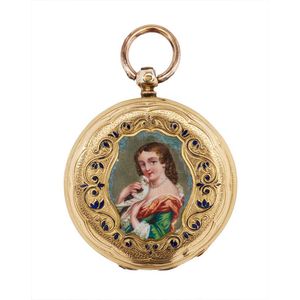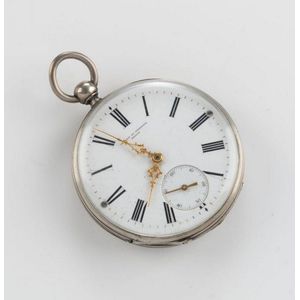
18ct Gold Open Face Pocket Watch by Constantin Mathey, Geneva
Lady's 18ct gold open face pocket watch by Constantin Mathey, Geneva, finely engraved case with gold plated cuvette, signed stem wind movement with lever escapement. Floral engraved gold dial with Roman numerals. Total weight 40 gm

Vacheron & Constantin 18ct Gold Pocket Watch, c.1931
A Vacheron & Constantin, 18ct gold ultra-thin open face dress pocket watch, 43 mm cased, fine lever movement with micrometer, numbered 416593, c.1931. Champagne dial with Arabic numerals at quarters, baton indices for other hours, railtrack minutes, subs…

Enamel Pocketwatch by Vacheron, 1822
A gold and enamel pocketwatch by Vacheron, key wind and set, circular gold dial with black Roman numerals, to an engraved case with hand painted portrait detail, in 18ct gold, diameter 33 mm, circa 1822. The watch presents in good overall condition, with…

Vacheron Constantin Watch Box with Certificate and Packaging
A Vacheron Constantine watch box, with certificate, identity card, seal and all original packaging, unused, dimensions, 95 x 195 x 195 mm.

Vacheron Constantin Gold Pocket Watch, Excellent Condition
A gold pocket watch by Vacheron Constantin, crown wind movement, circular white dial with black numerals, subsidiary seconds dial at six, 18ct gold case, diameter 50 mm. The pocket watch present in very good condition overall. Glazing and dial are in very…

Vacheron Constantin Silver Pocket Watch with Filigree Hands
Vacheron Constantin open face pocket watch in silver case, subsidiary seconds with filigree hands, 4.5 cm diameter

Vacheron & Constantin 18ct Gold Hunting Watch, 1920
Vacheron & Constantin An 18ct gold hunting cased watch mvt 397592 case 249660 circa 1920, lever movement, fully jewelled, white enamel dial, Arabic numerals, outer minute track, subsidiary seconds dial, gold spade baton hands, gold cuvette, plain polished…

Vacheron & Constantin Military Pocket Watch with Original Case
A Vacheron & Constantin sterling silver military pocket watch, cream dial, black arabic numerals, blue hands, second subsidiary dial. Engraved Vacheron & Constantin Swiss ffb9 279574 N, with original case

Vacheron & Constantin 18ct Gold Pocketwatch with Two-tone Chain
Vacheron & Constantin an 18ct gold openfaced pocketwatch mvt 328962 case 199079 circa 1910, manual winding jewelled lever movement, gilt dial with engine turned centre, painted black Arabic numerals, blued steel Breguet hands, subsidiary seconds at 6,…

Vacheron & Constantin Gold Chronograph Pocket Watch
A gentleman's gold hunter chronograph pocket watch, Vacheron & Constantin. 55 mm. Crown wind. Movement number 569955. Case number 229459. Case, dial, cuvette and movement signed. White enamel dial, black Arabic numerals, sweep seconds, subsidiary seconds…

1910 Vacheron & Constantin 18ct Gold Pocket Watch
Vacheron & Constantin, an 18ct gold open-faced pocket watch, circa 1910 lever movement, 16 jewels, white enamel dial, Arabic numerals, Breguet hands, subsidiary seconds, polished gold case, case, dial, movement and cuvette signed, diameter 47 mm, not…
 Loading more...
Loading more...